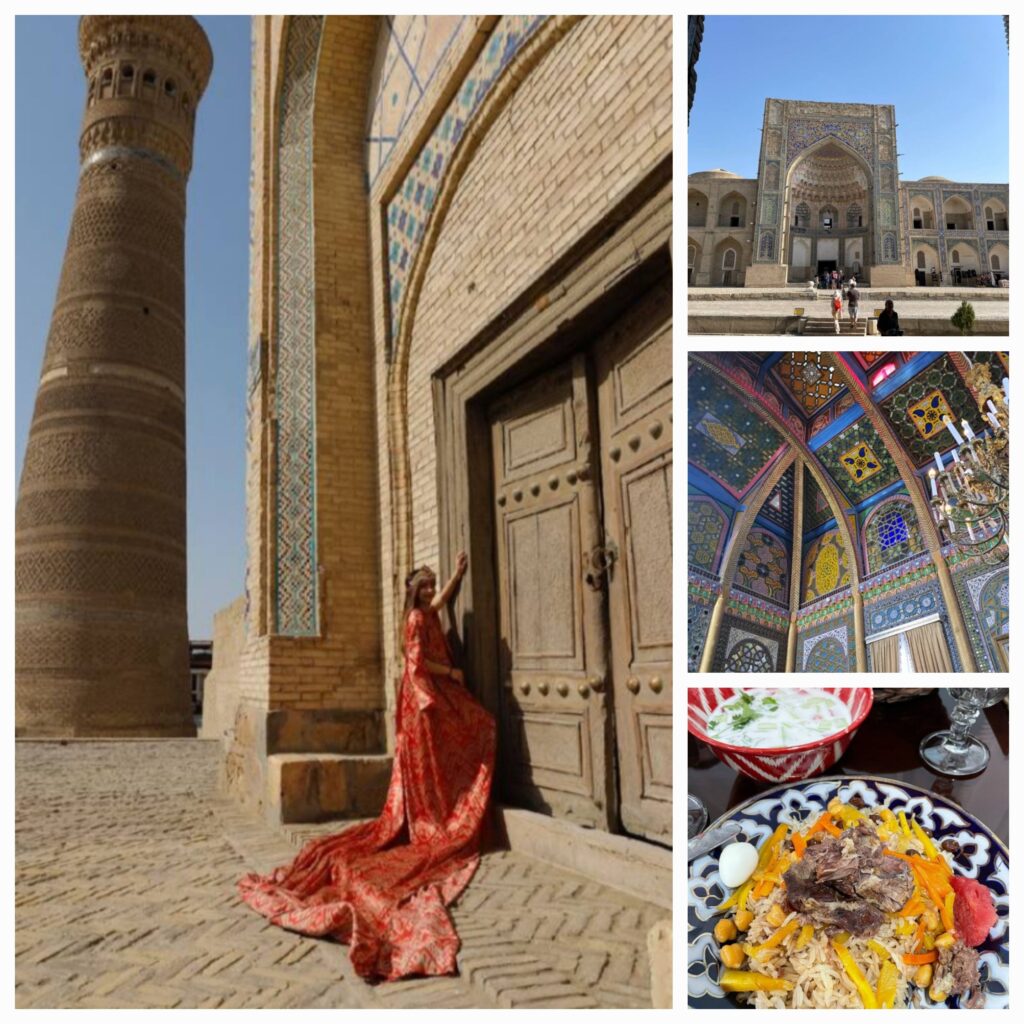Why visit Buxoro in Uzbekistan?

I have just returned from a trip to Uzbekistan and would like to share my unforgettable experience in Bukhara (Buxoro), a magical city straight out of a fairy tale.
Visiting Bukhara is like traveling through time, walking in the footsteps of great civilizations and marveling at every corner.
A Living Heritage
Nestled in the heart of Uzbekistan, Bukhara is more than just a historical city: it is an open-air museum, a crossroads of civilizations, and a gem of the Silk Road. With over 2,500 years of history, the city has captivated me, and I can’t wait to return.
Bukhara is a city with a rich historical and cultural heritage. During the Timurid era, it was a major scientific, literary, and cultural center of the Turkic-Muslim world, alongside Samarkand. The city’s architecture reflects the wealth of its history and the empires that ruled it, from Emir Timur to the Karluk civilization.
Architectural Treasures
The monuments, madrasas, mosques, and minarets of Bukhara are internationally recognized and continue to attract global attention. The city has preserved its historical heritage remarkably well, making it one of my favorite historical destinations.
Since the 9th century, Uzbeks have settled in Bukhara, and remnants of their historical architecture are found throughout the city. The Kalyan Minaret, built in 1127 under the Qarakhanids, stands 47 meters tall and is a symbol of the city. It has been a UNESCO World Heritage Site since 1993 and served both religious and defensive purposes.
Another significant monument is the Magoki Attar Mosque, dating back to the 12th century. It is considered the oldest surviving building in Bukhara. Before the first synagogue was built, Jews and Muslims prayed together in this mosque, symbolizing the city’s religious harmony.
In the 14th and 15th centuries, Bukhara flourished again under the Timurid dynasty. The construction of madrasas, mosques, and palaces thrived. The Ulugh Beg Madrasa, with its dominant blue tiles—Amir Timur’s favorite color—is a masterpiece of Timurid architecture and a UNESCO heritage site. These madrasas were not only beautiful but also centers of science and culture during the Timurid Renaissance.
According to E. Rtveladze, as cited by Sayfutdinov (2025), ‘The Ulugbek Madrasa was a major scientific center not only of Bukhara, but of the entire Transoxiana.’
In the 17th and 18th centuries, under the Ashtarkhanid dynasty, the Lab-i Hauz ensemble was built, including the Nadir Devonbegi Madrasa, a khanqah, and a central pool.
One place that truly enchanted me was the Summer Palace of the Emirs of Bukhara. This splendid palace blends Turkic, Persian, Muslim, and European architectural styles. It is one of the most beautiful architectural sites I have ever seen.
Other must-see sites include the Bukhara Fortress—one of the best-preserved in the world—the Chor Minor minarets, and the Lyabi Hauz square.
A Culinary Destination
Beyond architecture, Bukhara is a perfect destination for culinary tourism. Uzbek cuisine ranks in my top 3 world cuisines, and the traditional dish plov (osh) is exceptional in Bukhara. Since 2016, Uzbek plov has been recognized by UNESCO as part of the intangible cultural heritage and is among the top 15 culinary traditions. There are over 200 varieties of plov in Uzbekistan, and the one in Bukhara is among the best I’ve ever tasted.
A City to Experience
What makes visiting Uzbekistan so special is not only the architecture and food but also the warm hospitality, traditional clothing, dances, and music—from Sherali Jo’rayev to Sevara Nazarkhan. During my stay, I even tried on traditional attire and took photos to share on social media.
Conclusion
Bukhara’s architecture holds a unique place in world heritage, distinguished by its historical, religious, and aesthetic significance. The city is also a vibrant center of craftsmanship—handmade carpets, ceramics, silk embroidery, and miniatures. Visitors can not only purchase these treasures but also watch artisans at work.
Monuments such as the Ismail Samani Mausoleum, the Mir Arab Madrasa, the Kalon Tower, and the Lab-i Hauz ensemble are proud symbols of Uzbek history. Today, they are protected as integral parts of Uzbekistan’s and the world’s cultural heritage.
Bibliography
Marupova, A. O. (2009). The influence of tourism on local culture in Bukhara. Актуальные проблемы гуманитарных и естественных наук, (5), 321–325.
Sayfutdinov, F. (2025). Bukhara Architecture: Historical Heritage and Its Significance. Modern Science and Research, 4(3), 485–492.
UNESCO. (2016). Palov culture and tradition. UNESCO Intangible Cultural Heritage. https://ich.unesco.org/en/RL/palov-culture-and-tradition-01166

